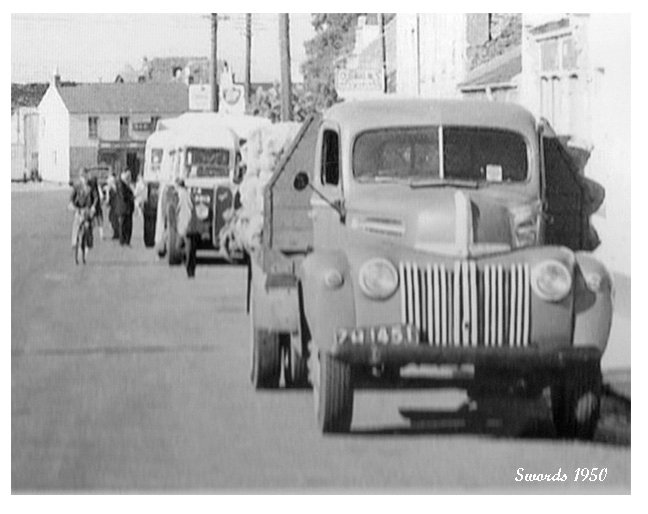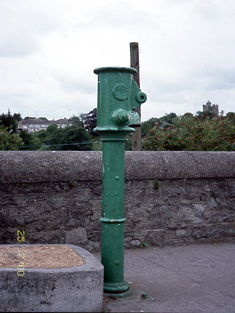|
|
Side Streets of Swords Dublin
 On the left going north, at the entrance to town, at O'Tooles Public House, is a road leading to the village, called
the Forest, this was the Forest Road. About 50 thatched and slated cabins
are on each side of the road for about 200 yards, and a small side street off it called the Bell Race. All these cottages were let at about 1/- a week, and were occupied by labourers, Connors, O'Tooles, Savages, McNultys, and other names I cannot remember. Below O'Tooles Pub is a straight road leading diagonally to the left and to the river and the Protestant Church, called the New Road. There were no houses on this road. At the Bridge at the end of this road, a lane led . along the river to the right, called the Hollow Lane, which had a row of about six delapidated cabins and the Lane turned again right back into the Main Street. At the bridge end of this lane, there was a two storey stone building standing in its own grounds, which was a Protestant Boarding School for boys which is now The Old School House Pub Between the cottages and the river bank, there was an open grassy space and grassy mounds which were called the Hollow
Banks, and a favourite playground for boys and girls.
Next turn left was the opening of the Hollow Lane, where it mat the Main Street. Next turn left was Connors Lane, which was a narrow lane leading to the river for drinking horses, washing cars and drawing water. There was one cottage in this lane. Next left turn was Earley's Lane, already referred to. Next left turn, a strip called The Green. The Village Pound was about 50 yards down this street, on the right, at the side of a Public House, O'Connors. A row of.slated houses on the left brought you to the village watermilI . Beyond the millhouse, there was a bridge across the river Ward. From the bridge, there was a nice view of the Mill Race.
The river was daxamed by a weir which made a picturesque waterfall with the mill wheel on the left and a neat cottage surrounded
with tall poplar trees on the right, gardens, trees, and low hills in the background of the sheet of water of the mill race.
This cottage was occupied by Widow, Nag Murphy, a well known character who reared a nice family. Nag could tell the history
of everyone in the town, and was always a figure at every wake in the town.
A hill rose above this bridge and the road forked left to the Protestant Church. On this road, there were several large
walled in dwellings standing in their own gardens, all occupied by Protestant gentry, including the Protestant Rector and
Curate. At the brow of the hill was a row of thatched and slated cottages and a farmyard, where Savages' long car and hackney
hired cars were stabled.
On the right from the bridge, there was a stone quarry, where limestone rocks were blasted for roadmaking. A few cottages
fronted the river in a place called the Rock Garden. The road to the right at the mill hill leads to Co. Meath. There were
many rows of mud thatched cabins in side roads from this road. This was the very old part of the town, all this area was called
The Green.
The next turn on the left led. off the Main Street at the Big Tree Public House at the end of North Street. This road
led to Balheary. No houses on this road near the town.
Starting from the south again; on the right side from O'Tooles Pub, the first turn was a small Cul de Sac, with about six cottages, called John's Lane. Next turn, Malahide Road. Walshs, Pump Contractors, had a cottage and store yard on the right of this road, and further on a large gentleman farmer's residence in its own grounds, Sneyds, a big Protestant farmer.- Next to Sneyds was Longs of Malahide Road, a big farmyard and nice residence and gardens. Nicholas Long leased all Colonel
Foster's lands, and had many acres of his own adjoining his house. His fields, called Barry's Pax', were often used for football
matches. A considerable amount of his land was rented from Colonel Foster on the eleven months system, that is for only eleven
months of the year, excluding the month of May. During this month, there was greatest growth of grass. He let people of the
town graze their cows in milking fields at a small weekly amount per each cow, usually one cow for each family.
Next to Longs was Proctor's (ex. R.I.C.) and the Legal Process Server, for the district. He had a large family and did
well in life. The next turn on the right was the Chapel Lane, which led to the Roman Catholic Church and Graveyard, and led.
through Colonel Foster's demesne, to join the Malahide Road. Traffic was only allowed as far as the Chapel. The remainder
was a ped-
j estrian path, only except for carts entering fields from the Nalahide Road end. Below the Chapel Lary on the right, skirting the Foster demesne, was Seatown Lane or School Lane. The Boys' School, Principal
Teachers' Residence, and Parochial House. Foster's farm buildings and a few mud thatched cottages were the only houses in
the first part. Lower down, near the estuary, there were a couple of farm houses and a few isolated cottages. Cuffes Farm
and old Georgian House in picturesque grounds, Smiths farmhouse and M Kerns, just on the estuary.
|
||||||
|
Next Page A History Of Swords - Public Buildings
|

